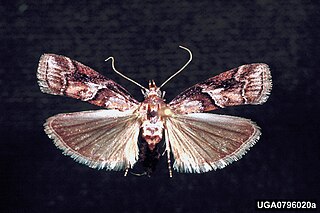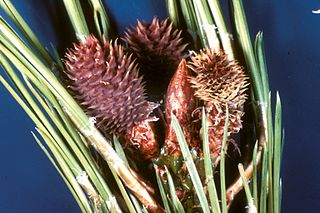
Dioryctria abietella is a moth of the family Pyralidae. It is found in Europe.

Dioryctria sylvestrella, the new pine knot-horn or maritime pine borer, is a moth of the family Pyralidae. It is found in Europe, parts of Asia and North Africa. The adult is a small mottled brown and white insect with a wingspan of 28 to 35 mm. The moth flies in a single generation from June to October and is a pest of maritime pine and several other species of pine, on which the caterpillars feed.

Dioryctria schuetzeella is a moth of the family Pyralidae. It is found in most of Europe, except the Balkan Peninsula, the Iberian Peninsula, Ireland and Ukraine.

Dioryctria simplicella is a moth of the family Pyralidae. It is known from Europe, except the southern parts.

Dioryctria zimmermani, the Zimmerman pine moth, is a moth of the family Pyralidae. It is found from southern Canada and the north-eastern and Great Lakes areas of the United States. There is a disjunct population in eastern Nebraska.

Dioryctria clarioralis, the blister coneworm moth, is a moth of the family Pyralidae. It is found in the eastern United States, including Florida, New Jersey and Virginia.

Dioryctria albovittella, the pinyon tip moth, is a species of moth of the family Pyralidae. It is found in North America including New Mexico.

Dioryctria auranticella, the ponderosa pineconeworm moth, is a moth of the family Pyralidae. The species was first described by Augustus Radcliffe Grote in 1883. It is found in western North America from southern British Columbia south to California and Arizona, east to South Dakota and New Mexico.

Dioryctria amatella, the southern pineconeworm moth, is a species of moth of the family Pyralidae. It is found in the south-eastern United States, from Maryland south to Florida and west into Texas.

Dioryctria reniculelloides, the spruce coneworm, is a moth of the family Pyralidae. The species was first described by Akira Mutuura and Eugene G. Munroe in 1973. It is found from Nova Scotia to Alaska, south in the east to New York, and south in the west to California and New Mexico. It was recorded from China in 2009. Occasionally abundant, often in conjunction with epidemics of the spruce budworm, the spruce coneworm occurs through most or all of the range of spruce in North America, feeding on new foliage and cones of spruce, and often balsam fir. When abundant, it can be a serious pest "particularly on white spruce".

Dioryctria disclusa, the webbing coneworm or rusty pine cone moth, is a species of moth of the family Pyralidae. It is found in North America from New Brunswick to Florida, west to Texas and north to Manitoba.
Dioryctria cambiicola, the western pine moth, is a species of snout moth in the genus Dioryctria. It was described by Harrison Gray Dyar Jr. in 1914 and is found in North America from British Columbia and Alberta south to California and New Mexico.
Dioryctria merkeli, the loblolly pine coneworm moth, is a species of snout moth in the genus Dioryctria. It was described by Akira Mutuura and Eugene G. Munroe in 1979 and is found in the eastern United States including Maryland, Texas, Mississippi, Georgia and Florida.
Dioryctria rubella, the pine shoot moth, is a species of snout moth in the genus Dioryctria. It was described by George Hampson in 1891 and is known from south-east Asia, including China and the Philippines.
Dioryctria taedae is a species of snout moth in the genus Dioryctria. It was described by Schaber and Wood in 1971, and is known from Maryland to the south-eastern United States.
Dioryctria taedivorella, the lesser loblolly pineconeworm moth, is a species of snout moth in the genus Dioryctria. It was described by Herbert H. Neunzig and Nancy Antoine Leidy in 1989, and is known from North America, where it is found from eastern Virginia and North Carolina to northern Alabama and Mississippi.
Dioryctria taiella is a species of snout moth in the genus Dioryctria. It was described by Hans Georg Amsel in 1970 and is known from Afghanistan and Pakistan.
Dioryctria vancouverella is a species of snout moth in the genus Dioryctria. It was described by Akira Mutuura, Eugene G. Munroe and Douglas Alexander Ross in 1969, and is known from southern British Columbia, Canada. It is named for the city of Vancouver, from which the type specimen was collected.
Dioryctria yatesi, the mountain pine coneworm, is a species of snout moth in the genus Dioryctria. It was described by Mutuura and Munroe in 1979, and is limited to the mountains of the coastal south-eastern United States and Tennessee.















